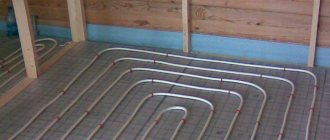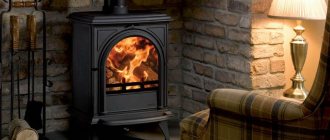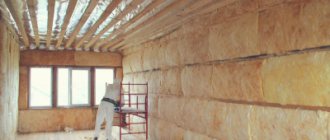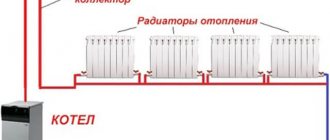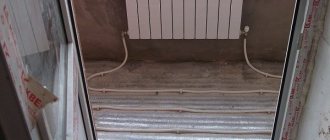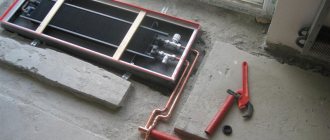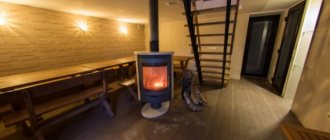Variety of heating systems
Almost every home uses autonomous equipment for heating. All heated floors can be classified according to various criteria :
- operating principle;
- type of boiler;
- coolant.
In individual houses a boiler can be installed , which uses for its operation :
- solid fuel;
- diesel fuel;
- gas;
- electricity.
In a heating system, the coolant can be :
- air;
- water;
- electricity.
According to the principle of operation, all heated floors can be of infrared or convective type.
Source stroyfora.ru
To make a film heated floor, a special film with heating elements glued to it is laid under the floor covering.
Each of the above types has its own advantages and disadvantages. All of them must be taken into account at the design stage. In doing so, experts take into account many different factors.
The most common, accessible and cost-effective in our country is gas heating.
When installing a heated floor, take into account the characteristics of the material from which the structure is made. For example, wood is characterized by a low thermal conductivity.
Installation of underfloor heating with liquid coolant
As we know, private homes often have a centralized gas supply. Many people install double-circuit boilers, which provide hot water in the pipeline. In this situation, it is better to choose water as a coolant. But if you do not live in a country house, but only come for the weekend, antifreeze will be the best coolant. In this case, you will not have to drain the water from the system and pipes every time.
There are 2 types of liquid heating systems: open and closed loop. The difference between these types lies in the design of the expansion tank.
Source cabel-electro.ru
Open type expansion tank in the heating system
See also: Catalog of companies that specialize in insulating country houses.
An open loop system consists of a tank that is in direct communication with the atmosphere. During heating, the volume of liquid increases. It can be compensated in a simple way - add the required amount of water to the container. But the closed circuit system is characterized by a special design of the expansion tank.
Warm floors with liquid coolant include:
- boiler and circulation pump;
- expansion tank and Mayevsky tap;
- distribution unit and safety valve;
- pipelines.
The water in the heating system is constantly heated by the boiler, which monitors its temperature. The heated water enters the main collector, and then into the distribution unit. Here there is a uniform distribution of warm water through all pipes in all rooms. Thanks to this, the temperature throughout the house will be the same. The installation of water heated floors in a private house should be carried out by a specialist.
Source cabel-electro.ru
Closed expansion tank in the heating system
Options for arranging heated floors
For heated floors, you can install a water or electric heating system. If desired, any of these structures can be hidden under the laminate and laid on a wooden floor, so we will consider all the options to choose the best one.
Types of electrical systems
Electric underfloor heating is considered the optimal solution for heating floors with dry screed. It does not require the creation of a complex multi-layer structure and concrete pouring, and even a beginner in the repair business can handle its installation.
True, there are several types of electrical systems, each of which has its own characteristics and installation nuances.
The “progenitor” of warm electric floors is the cable system. To install it, a well-insulated heating core is cut into sections and laid on the floor, secured with special clamps. When connected to electricity, the cable transfers heat to the floor covering.
A more modern version of the design is thermomats, in which the wiring is already fixed to a fiberglass mesh, which greatly simplifies the installation process.
Infrared film flooring is the most popular option today for installation on a wooden floor under a laminate. Essentially, this is a film with polymer strips sealed inside with a thin layer of carbon fiber, silver or graphite, which, when connected to the network, emits electromagnetic waves in the infrared range.
The main feature of this design is the absence of glowing elements, due to which heat is released without the threat of self-ignition.
Warm carbon floor is another system based on the work of infrared rays. It is based on carbon rods connected to each other by a high-strength copper cable.
Although this design is quite expensive, it has a number of advantages over other types of heating: it does not heat up, consumes minimal energy, automatically controls the heating temperature and is not afraid of the load from heavy furniture.
Advantages of infrared floors compared to cable ones:
- Heating is faster and more uniform , because the cable heats the coating only in places of contact with the floor, and the film heats up its entire area.
- Easy to install - the film system can be installed in literally an hour of work and you can immediately begin laying the laminate.
- Reliability - in the event of mechanical damage, only one segment fails, and the system continues to operate.
- Health Benefits – Far infrared radiation supports the immune system and is even used to treat certain diseases.
In general, electrical systems have relatively few disadvantages. For example, it may be difficult to rearrange furniture, since heavy objects can pinch the cable or film and damage the structure.
Well, the most important disadvantages, like any electrical device, are high energy consumption and the danger of a short circuit with subsequent ignition of wooden materials. Infrared and carbon fiber floors are most reliably protected from the latter.
Advantages and disadvantages of a water circuit
Water heated floors are small-diameter pipes laid under a decorative floor covering and connected to a heating boiler or central heating system.
Although it is traditionally recommended to lay the water circuit on concrete, for heated floors in a wooden house, you can also install a dry screed under the laminate so as not to overload the floors.
Advantages of a water circuit on a wooden substrate:
- Economical . Minimum energy costs compared to other types of heated floors.
- Safety . There is no risk of short circuits and spontaneous combustion of materials.
- Maintainability . If repairs are necessary, you can simply remove the laminate and replace the problematic section of the pipeline without having to deal with dismantling the concrete screed.
The main disadvantage of the water system is that for its operation it is necessary to start the boiler and wait for the coolant to warm up, so there will be no rapid heat transfer. And if the system is connected to centralized heating, then it will only work during the heating season.
By the way, it is prohibited to install such structures without authorization in apartment buildings, so connecting heated floors to radiators is only possible in a private house.
The pipes also have lower heat transfer - they do not fit as tightly to the laminate as infrared film or electrical cable, although this issue can be partially resolved by installing heat distribution plates.
Well, the last drawback is the complexity of installation, which will require both accurate calculations and experience, so it is better to entrust it to specialists.
Pros and cons of using water floors
Compared to radiators and convectors, water heated floors have many advantages :
- comfort;
- economy;
- aesthetics;
- safety.
Warm floors allow you to evenly heat the entire area of the room, creating the ideal temperature for human health. There are no drafts on this floor and it is comfortable to play on with children.
Due to the low temperature of the coolant, energy consumption is reduced by 20−30%. By installing such a heating system in large rooms with high ceilings, you can save up to 60% by heating the air only 2.5-3 m in height.
This type of heating allows you to carry out various projects for remodeling the premises. There are no radiators here, which so often spoil the appearance.
The possibility of injury or burns upon contact with coolant is eliminated. Therefore, this heating system is safe even if there are small children in the house.
Source pikucha.ru
Warm floors can always be adjusted to a comfortable temperature
The disadvantages include:
- cannot be used on staircases;
- labor-intensive installation of the structure;
- the likelihood of a pipeline leak.
Types of pipes used
Metal-plastic and plastic pipes can be used to equip heated floors. Many plumbers have positively assessed cross-linked polypropylene pipes. They are characterized by a high degree of tightness, resistance to deformation and good thermal conductivity.
When choosing pipes for installing heated floors, carefully study their technical characteristics. In particular, pay attention to the suitability of the material for use in heating systems. Be careful, because some unscrupulous sellers may sell pipes intended for plumbing. As a result, the floor heating system will be ineffective. Therefore, pay attention to the markings on the pipes. Indicators that you should focus on when choosing pipes for installing heated floors:
- linear expansion (up to 0.025 mm/m);
- thermal conductivity (more than 0.43 W/m °C).
You can find out the required number of pipes, taking into account the diameter of the material and the pitch of its installation.
Source hydrost.ru
When selecting pipes for heated floors, there are a number of nuances, so it is better to entrust the choice to professionals
In what ways can pipes be laid on a dry screed?
The use of heated floors in a wooden house does not impose restrictions on pipe laying methods. The main thing is to avoid joints of products - places with an increased risk of leaks. Pipes can be laid in a polystyrene or wooden slab in the following ways:
- spiral (snail) - a universal method that allows you to ensure uniform heating of the floor surface;
- snake or double snake - a method for laying water floor pipes in small rooms;
- corner snake - if the useful heated area is concentrated in the corner of the room.
When installing a water floor without a screed, take into account the number of external walls. The coldest zones will be here, so the pipe laying step is reduced to reduce heat loss. In order not to make a mistake and correctly calculate the amount of consumables, it is recommended to make a plan drawing of the premises. If their area is large (over 20 m2), 2 or more circuits are provided in the system for heating the air masses from below. This trick will ensure uniform heating of the surface.
Electric heated floor installation
The essence of the operation of an electric heated floor is that the conductors that are under load are heated. And the level of temperature increase depends on the resistance of the material. At the moment, there are 2 ways to install such a heating system: cable and film.
Cable heated floors have much in common with water ones. Simply, instead of pipes with warm water, an electric cable is laid under the floor. It heats up by passing electricity through it. Managing such a heating system is simple - you just need to adjust the periods of power on and off. In other words, when the room reaches a certain temperature, the system will turn off, and when it cools down, it will turn on.
Advantages of heated floors
Thanks to its advantages, this system is increasingly penetrating our modern life. Let's consider the main consumer advantages of the system:
Landscaping and aesthetics of the system
In other words, this is a comfortable temperature of the heated surface and a comfortable temperature in the room. In addition, in a place with such a system, there is no zone of local overheating and barely warmed areas. There are no visible elements of the heating system. The system is not tied to the arrangement of furniture in the room.
In buildings with underfloor heating, heat is transferred not by convection, but by thermal radiation. In other words, the transfer of thermal energy occurs from one particle to another. The convection component is of course present, but it is no more than 10% of the total thermal radiation and in this case it can be completely neglected.
Versatility
The next advantage of underfloor heating is that you can use any energy source, any heat generator, any type of coolant and type of floor covering.
It is worth paying attention to the only nuance that concerns flooring - if we are dealing with, say, laminate, parquet boards, parquet or linoleum, here you need to pay attention to the packaging and carefully read the information indicated on it, whether you can or cannot use this type of floor covering when installing a “warm floor” system.
Health and Safety
Another advantage of heated floors is that there is no circulation of dust due to uniform heat flows, and there are no electromagnetic fields compared to electric heated floors.
This is all due to the presence of constant circulation of convection air flows in the room; with these layers of air, tiny dry particles and microorganisms move, which can cause allergic and negative reactions to the human body.
Energy efficiency
Quite an important plus of heated floors. Firstly, the temperature of the coolant that we supply to the underfloor heating pipes is the maximum possible according to the standards - 55°C. In practice, this figure reaches approximately 35-45 degrees. Accordingly, this will make it possible to reduce the cost of heating this coolant.
Secondly, due to the uniform distribution of heat in the room and the absence of the need to warm up the upper layers of air, the average temperature in the room decreases by about 2°C, without changes in the feeling of heat by a person. This reduction in average temperature leads to 15-20% savings in energy for heating this space. This is if we are talking about a room with a standard ceiling height of up to 3 meters. If we consider an industrial or sports facility with high ceilings, then these savings can reach up to 30% and 40%. During the heating season, which on average lasts about 200 days in our country, this is quite a significant saving in financial terms.
The third point is the vertical distribution of heat, again there is no need to heat the upper layers of air, which minimizes heat loss through the upper parts of the walls and ceilings.
All of the listed advantages of heated floors arise from the physics of the process itself. It is possible to increase energy efficiency by another 15-20% using various types of automation in our system, including weather-sensitive automation.
We are not always aware of how much this or that heating concept will cost us. We can see how much the equipment costs, according to the specifications, and we think that’s all. But this iceberg also has a small hidden part, which is significantly larger than its upper part. So, the top of the iceberg symbolizes the starting costs for equipment and installation. But a water heated floor system is not built for one year, but for many decades, so the hidden bottom of the iceberg shows the operating costs over the entire life of the system. We pay monthly for energy consumption, the more energy efficient the heating system is installed, the lower the monthly costs for energy consumption of our home will be.
Pros and cons of electric heated floors
Electric heated floors in a private home have many advantages . The main ones:
- reliability (leaks cannot appear);
- noiselessness;
- aesthetics;
- long service life;
- uniform heating of the entire area;
- simple controls.
Source pinterest.com
Instead of water pipes, electric heated floors use heating cables
Disadvantages of this heating system:
- the presence of weak electromagnetic radiation (harmless and safe for humans);
- high energy consumption.
The principle of organizing a heated floor into rack modules
Using this technology, it is a little more difficult to install a warm water floor in a private house without a screed with your own hands. The fact is that the method does not involve the use of ready-made flooring systems. Grooves for laying pipes and distribution plates are formed by installing boards. In fact, these are ordinary strips of wood. They have a thickness of 28 mm. When organizing a dry water heated floor, the boards are placed at a distance of 20 mm from one another. No preparation needed. The strips are laid directly on the logs, the distance between which does not exceed 600 mm or 300 mm. If this is a cable heated floor under a laminate without a screed or ceramic tiles are chosen as the final finish, then the distance between the floor beams should not exceed 300 mm. In other cases 600 mm.
This installation method involves the use of a heat-insulating layer - polystyrene, basalt wool, etc. It is laid strictly between the beams. When installing a water-heated floor in a wooden house without a screed using a rack-class wooden flooring system, plates are used for laying pipes with a pitch of 200 and 300 mm. And in areas near external walls, windows and doors - 150 mm. Afterwards, the installation procedure repeats the previous one.
It doesn’t matter what type of heating system you choose - electric heated floor under laminate without screed or water. The main thing is to correctly calculate the load on the system. Also, one should not lose sight of the location of the collector and automation. Stable and safe operation of the system depends on the accuracy of the design calculations. Despite the fact that dry screed for heated floors makes the installation of a heating system as easy as possible, this procedure is very responsible. Therefore, it is wiser to entrust it to professionals.
In order to calmly walk barefoot even in winter, sit by the fireplace or play with a child on a laminate floor, it is worth installing an additional heating system. But many owners of wooden houses are concerned about the compatibility of such a device with the fire and environmental safety of their home.
We propose to find out whether it is possible to make a heated floor under a laminate on a wooden floor, what are the pros and cons of such a solution. We will tell you how to choose the optimal installation method, and also describe in detail the technology for arranging a floor-type heating system.
Features of installing heated floors in a wooden house
In a wooden house, underfloor heating should be installed correctly. After all, wood has its own characteristics that must be taken into account. Remember, the temperature of a heated floor in a wooden house should not exceed 30 degrees. Otherwise, the wood will dry out, which will lead to premature failure of the material.
A warm water floor in a wooden house, like an electric one, must be installed at the construction stage or during major repairs - otherwise the installation cost will be very high. All installation and connection work must be carried out only by specialists. Please note that the subfloor must be pre-insulated.
When installing an electric heated floor, it is recommended to use an armored cable with an outer metal braid. It should also be taken into account that the cable can be damaged by rodents. And such a braid protects the cable from various external influences.
Source hr.decoratex.biz
Only at the construction stage will installation of heated floors not result in additional costs
The electric underfloor heating system must be connected to an electrical network with the required parameters. Devices are first installed on them to protect electrical wiring from short circuits.
Having decided to install a warm water floor in a wooden house with wooden floors, you need to level the surface well. The heating pipes are placed in a special box, which is then covered with boards. The box is made of wood, drywall or other material that will absorb moisture well. Afterwards the laminate is laid.
Cons of heated floors
Everything good has a downside. And we should talk about it too.
The disadvantages of heated floors are as follows:
High inertia system
Impossibility of sudden changes in air temperature in the room. Actually, we don’t always need this, unless of course you live in a country with a sharply continental climate. Where the daily temperature difference can be 15-20 degrees. Since in such a climate with heated floors it is impossible to quickly increase or decrease the heating temperature.
Output: Weather-dependent automation completely minimizes the inertia of heat flows.
Now about the next disadvantage of heated floors.
Limited floor area as a heating device
Since the floor area is limited, there is a limit to the heating output of the system.
Solution: If we still don’t have enough heat flow from this area and we don’t want to use additional sources like heating radiators, we can use walls. Accordingly, we will receive complete panel heating of our premises without visible heating elements.
Energy dependence
In some regions this is a rather significant disadvantage of heated floors . In the event of a power failure, the boiler, circulation pump, and automation are switched off. Against the background of all this, the only positive nuance in radiator heating can be considered that it is possible to maintain a certain natural circulation, a gravitational component. In heated floors, this natural circulation is impossible due to high hydraulic resistance. Therefore, the system is truly energy-dependent, but at the same time, due to its inertia, it will take many times longer for a room with a heated floor to cool down than where a radiator system is installed.
Lack of air circulation
This is both a minus and a plus of heated floors at the same time. In the case where more windows will be used in your home, be prepared for the fact that heated floors will probably not cope with cutting off cold flows. Plus, at a height above two meters, the windows will fog up.
Solution: Install in-floor convectors near large windows
Despite the many far-fetched disadvantages, heated floors are truly an excellent heating system that you should definitely consider when arranging your home.
